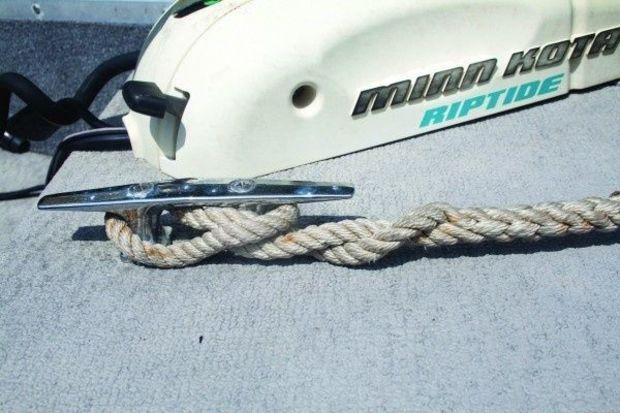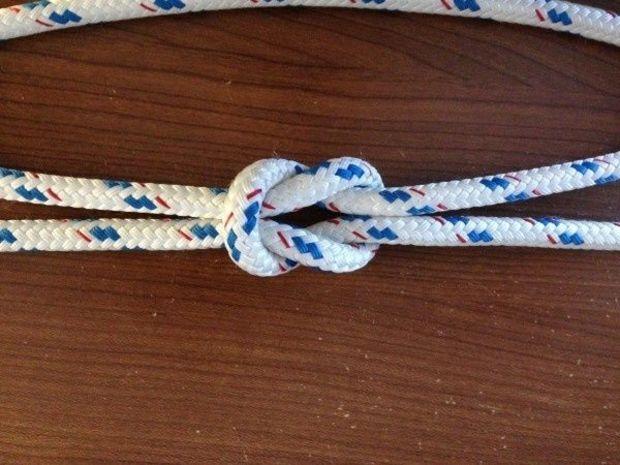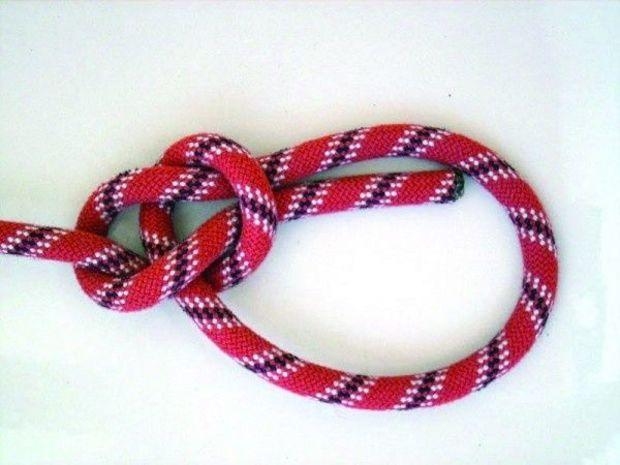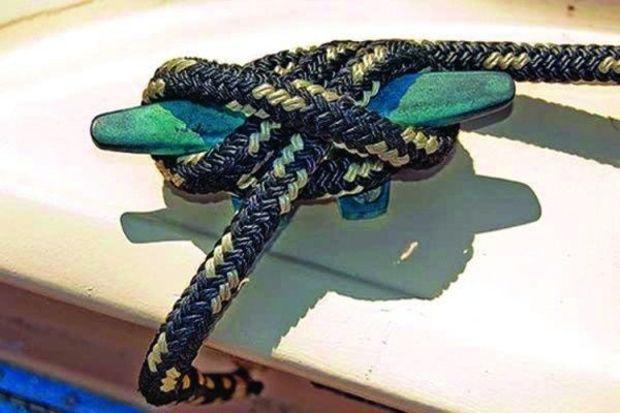As much as I hate to give blow boaters credit for anything, other than being in the way of power boats, I must say they usually have a better understanding of marlinspike seamanship than those of us who burn old dinosaurs to power our boats. Since sails are controlled by a series of lines, it makes sense that sailors understand the inner workings of the materials and knots that make up their control systems in the same way we have to have a working knowledge of the internal combustion engine.
While ropes and lines are not used as much by powerboaters, they are still important parts of the boating experience. If you have ever tried to untie a dock line that was left in a granny knot, you can appreciate proper marlinspike seamanship.
 Dock Lines
Dock Lines
This is the one area where all boaters should learn the proper way to tie up their craft. It doesn’t matter if your boat is on a trailer or kept in the water; if you can’t tie the proper knots to make it secure, you are going to have problems.
As a trailer boater, I keep a line ready with an eye splice in one end that I secure to the bow cleat before launching. My partner will use this line to control the boat once it is off the trailer, then secure the boat to the dock while I park the truck.
To tie off to the cleat on the dock, take one turn around the cleat, then use half hitches to secure the line. The half hitches may be loosened to let in or take up line as needed. They will not jam tight and are easily released when it is time to get under way.
My partner will remain on the dock until I start the motor and make sure everything is running correctly. Then he will release the line while I hold the boat to the dock. Once onboard the line will be coiled and placed out of the way until we return. Leaving a line on the bow can result in problems should it fall into the water while underway. Unless you have that experience, it may be difficult to believe how quickly a boat can stop when a line tied to the bow cleat gets caught in the prop.
The other line of great importance to the powerboater is the anchor rode. Select the proper size for your boat, and then tie a thimble into an eye splice and connect the anchor chain to the line with a shackle. Another shackle is used to connect the chain to the anchor.
I keep a long line onboard ready at a moment’s notice in case I need to be towed. This line has an eye splice on one end and that can be tied to my bow cleat. The line is kept in a coil that (in theory) can be tossed to the other boat. I have been in situations where wind and seas made tossing anything difficult, let alone a coil of towing line. In a perfect world I would have a heaving line ready, but I don’t live in a perfect world. A towing service can do all of this quickly and efficiently, but there are times when waiting for a tow is not an option, so it pays to be as ready as possible to help a good Samaritan when he comes to your aid.
 Types of Line
Types of Line
Most recreational boaters will be well served by nylon rope. It has some stretch so it is an excellent choice for dock and anchor lines.
While it will resist deteriorating, I found out, much to may regret, that when left for a long period of time sitting under an anchor and exposed to the elements, nylon line will fail. In an effort to prevent a repeat performance and the expense of a new anchor, chain and line, I now check my anchor rode regularly and do not let the anchor sit on top of the line.
If you plan to anchor in deep water, you will need a considerable amount of rode. Those who fish the canyons for tuna may end up having to anchor in 600 feet or more, and they will store the extra line in milk carton-like plastic boxes. These have openings on the sides and bottom so air can circulate to aid in drying the line and keeping it mildew free. These boxes can be stored ashore until a chunking trip is planned.
While polypropylene rope is cheaper than nylon, it is nowhere near as strong and does not hold up well when exposed to the elements. The fact that it floats does make it ideal for use on crab pots, ski tow ropes, and similar applications.
Braided lines are another common type and are often sold ready for use as dock lines. They are very smooth and resist abrasion better than nylon.
 Knots
Knots
In addition to the half hitch, there are a few knots that all boaters should be able to tie. The bowline will form a loop in a line that will not slip. It can be used to lift a person from the water by placing the loop over the head and under the arms.
The square knot is easy to tie and can be used to join two lines together.
There are many other knots that can be useful, but space does not permit diagrams illustrating how to tie these knots. Fortunately, in this computer age there are numerous internet sites that do the job very well. Old school boaters can purchase Chapman Piloting, Seamanship and Small Boat Handling or other books dedicated to marlinspike seamanship.
 Storing Your Lines
Storing Your Lines
Lines should be stored out of the weather whenever possible. In addition, they should be coiled properly before storage so when they are needed, time is not lost untangling the lines.
If, like me, you have an open boat with very little storage, keep your lines in a safe location, out from under foot, but ready for use.
It is pretty hard to do any type of boating without some sort of line. Even kayaks have a bow line and some have an anchor line. The more you know about marlinspike seamanship, the better you will treat your various lines and the better they will serve you.
by Eric Burnley Dock Lines
This is the one area where all boaters should learn the proper way to tie up their craft. It doesn’t matter if your boat is on a trailer or kept in the water; if you can’t tie the proper knots to make it secure, you are going to have problems.
As a trailer boater, I keep a line ready with an eye splice in one end that I secure to the bow cleat before launching. My partner will use this line to control the boat once it is off the trailer, then secure the boat to the dock while I park the truck.
To tie off to the cleat on the dock, take one turn around the cleat, then use half hitches to secure the line. The half hitches may be loosened to let in or take up line as needed. They will not jam tight and are easily released when it is time to get under way.
My partner will remain on the dock until I start the motor and make sure everything is running correctly. Then he will release the line while I hold the boat to the dock. Once onboard the line will be coiled and placed out of the way until we return. Leaving a line on the bow can result in problems should it fall into the water while underway. Unless you have that experience, it may be difficult to believe how quickly a boat can stop when a line tied to the bow cleat gets caught in the prop.
The other line of great importance to the powerboater is the anchor rode. Select the proper size for your boat, and then tie a thimble into an eye splice and connect the anchor chain to the line with a shackle. Another shackle is used to connect the chain to the anchor.
I keep a long line onboard ready at a moment’s notice in case I need to be towed. This line has an eye splice on one end and that can be tied to my bow cleat. The line is kept in a coil that (in theory) can be tossed to the other boat. I have been in situations where wind and seas made tossing anything difficult, let alone a coil of towing line. In a perfect world I would have a heaving line ready, but I don’t live in a perfect world. A towing service can do all of this quickly and efficiently, but there are times when waiting for a tow is not an option, so it pays to be as ready as possible to help a good Samaritan when he comes to your aid.
Dock Lines
This is the one area where all boaters should learn the proper way to tie up their craft. It doesn’t matter if your boat is on a trailer or kept in the water; if you can’t tie the proper knots to make it secure, you are going to have problems.
As a trailer boater, I keep a line ready with an eye splice in one end that I secure to the bow cleat before launching. My partner will use this line to control the boat once it is off the trailer, then secure the boat to the dock while I park the truck.
To tie off to the cleat on the dock, take one turn around the cleat, then use half hitches to secure the line. The half hitches may be loosened to let in or take up line as needed. They will not jam tight and are easily released when it is time to get under way.
My partner will remain on the dock until I start the motor and make sure everything is running correctly. Then he will release the line while I hold the boat to the dock. Once onboard the line will be coiled and placed out of the way until we return. Leaving a line on the bow can result in problems should it fall into the water while underway. Unless you have that experience, it may be difficult to believe how quickly a boat can stop when a line tied to the bow cleat gets caught in the prop.
The other line of great importance to the powerboater is the anchor rode. Select the proper size for your boat, and then tie a thimble into an eye splice and connect the anchor chain to the line with a shackle. Another shackle is used to connect the chain to the anchor.
I keep a long line onboard ready at a moment’s notice in case I need to be towed. This line has an eye splice on one end and that can be tied to my bow cleat. The line is kept in a coil that (in theory) can be tossed to the other boat. I have been in situations where wind and seas made tossing anything difficult, let alone a coil of towing line. In a perfect world I would have a heaving line ready, but I don’t live in a perfect world. A towing service can do all of this quickly and efficiently, but there are times when waiting for a tow is not an option, so it pays to be as ready as possible to help a good Samaritan when he comes to your aid.
 Types of Line
Most recreational boaters will be well served by nylon rope. It has some stretch so it is an excellent choice for dock and anchor lines.
While it will resist deteriorating, I found out, much to may regret, that when left for a long period of time sitting under an anchor and exposed to the elements, nylon line will fail. In an effort to prevent a repeat performance and the expense of a new anchor, chain and line, I now check my anchor rode regularly and do not let the anchor sit on top of the line.
If you plan to anchor in deep water, you will need a considerable amount of rode. Those who fish the canyons for tuna may end up having to anchor in 600 feet or more, and they will store the extra line in milk carton-like plastic boxes. These have openings on the sides and bottom so air can circulate to aid in drying the line and keeping it mildew free. These boxes can be stored ashore until a chunking trip is planned.
While polypropylene rope is cheaper than nylon, it is nowhere near as strong and does not hold up well when exposed to the elements. The fact that it floats does make it ideal for use on crab pots, ski tow ropes, and similar applications.
Braided lines are another common type and are often sold ready for use as dock lines. They are very smooth and resist abrasion better than nylon.
Types of Line
Most recreational boaters will be well served by nylon rope. It has some stretch so it is an excellent choice for dock and anchor lines.
While it will resist deteriorating, I found out, much to may regret, that when left for a long period of time sitting under an anchor and exposed to the elements, nylon line will fail. In an effort to prevent a repeat performance and the expense of a new anchor, chain and line, I now check my anchor rode regularly and do not let the anchor sit on top of the line.
If you plan to anchor in deep water, you will need a considerable amount of rode. Those who fish the canyons for tuna may end up having to anchor in 600 feet or more, and they will store the extra line in milk carton-like plastic boxes. These have openings on the sides and bottom so air can circulate to aid in drying the line and keeping it mildew free. These boxes can be stored ashore until a chunking trip is planned.
While polypropylene rope is cheaper than nylon, it is nowhere near as strong and does not hold up well when exposed to the elements. The fact that it floats does make it ideal for use on crab pots, ski tow ropes, and similar applications.
Braided lines are another common type and are often sold ready for use as dock lines. They are very smooth and resist abrasion better than nylon.
 Knots
In addition to the half hitch, there are a few knots that all boaters should be able to tie. The bowline will form a loop in a line that will not slip. It can be used to lift a person from the water by placing the loop over the head and under the arms.
The square knot is easy to tie and can be used to join two lines together.
There are many other knots that can be useful, but space does not permit diagrams illustrating how to tie these knots. Fortunately, in this computer age there are numerous internet sites that do the job very well. Old school boaters can purchase Chapman Piloting, Seamanship and Small Boat Handling or other books dedicated to marlinspike seamanship.
Knots
In addition to the half hitch, there are a few knots that all boaters should be able to tie. The bowline will form a loop in a line that will not slip. It can be used to lift a person from the water by placing the loop over the head and under the arms.
The square knot is easy to tie and can be used to join two lines together.
There are many other knots that can be useful, but space does not permit diagrams illustrating how to tie these knots. Fortunately, in this computer age there are numerous internet sites that do the job very well. Old school boaters can purchase Chapman Piloting, Seamanship and Small Boat Handling or other books dedicated to marlinspike seamanship.
 Storing Your Lines
Lines should be stored out of the weather whenever possible. In addition, they should be coiled properly before storage so when they are needed, time is not lost untangling the lines.
If, like me, you have an open boat with very little storage, keep your lines in a safe location, out from under foot, but ready for use.
It is pretty hard to do any type of boating without some sort of line. Even kayaks have a bow line and some have an anchor line. The more you know about marlinspike seamanship, the better you will treat your various lines and the better they will serve you.
by Eric Burnley
Storing Your Lines
Lines should be stored out of the weather whenever possible. In addition, they should be coiled properly before storage so when they are needed, time is not lost untangling the lines.
If, like me, you have an open boat with very little storage, keep your lines in a safe location, out from under foot, but ready for use.
It is pretty hard to do any type of boating without some sort of line. Even kayaks have a bow line and some have an anchor line. The more you know about marlinspike seamanship, the better you will treat your various lines and the better they will serve you.
by Eric Burnley